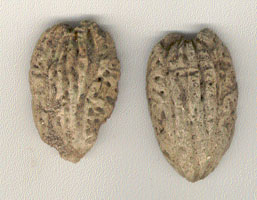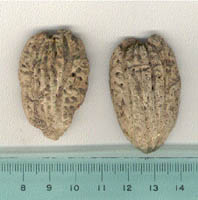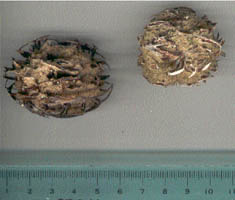
Nancy: Let's try out this image I scanned earlier. I think that the largest may be Borassus of some sort, maybe flabelliformis? The others I had some ideas about, but cannot find my notes as to what I thought -- oh well, that way I won't be confusing your identification. Whatever these are, they almost certainly didn't come from across the atoll!

Nancy: hope I didn't kill the poor seedling, but this morning I extracted the seed covers from around it and then scanned it (both sides at once since they had broken apart). Upon looking at these seed covers again, it is possible that they are just tattered Terminalia catappa. But then again, they may be slightly different. We may have to hope that the plant will survive and wait until it gets bigger. Even a T. catappa would not be a bad tree to have (unlike Barringtonia asiatica we planted and the neighbors hate!)


David Lorence: The second image of Nancy's certainly looks like the seed endocarp of a Terminalia species, but without a scale in the picture it's difficult to tell which one. The endocarp of T. carolinensis measures 4-4.5 x 2-2.5 cm, whereas that of T. catappa is larger and measures 4-6 x 3-4 cm (measurements taken from PTBG herbarium specimens). Smaller-fruited catappa fruits overlap in size somewhat with the carolinensis. Regarding the first image with 3 seeds: the lower left-hand seed with a furrowed seed coat much resembles Hernandia nymphaeifolia; the upper left-hand one I don't know; the right-hand one certainly resembles a palm seed and could be Borassus. Aloha, David Lorence
Nancy: Thanks both of you for your help. I certainly should have put my trusty ruler next to the Terminalia when I scanned it (I often do). I have rescanned it now with it, so hope that helps. I don't think that the black wrinkly seed is Hernandia. But to be more sure, I sawed one -- you can see from the image [below] that it is a chaulky white inside and it does have a strong aroma (almost pleasent by actually quite stinky). I don't think that is the Hernandia is like this. The black wrinkles are not hard, not as I expect Hernandia's would be, especially after the length of time these have been at sea, as evidenced by the marine growth on them. The new one I think is a Spondias, but I don't know what kind. It seems that whatever it is, the ants like it and are eating out the center on the one I have had for a while. Any thoughts as to why all Xylocarpus are very dead when they get here? Glad to know I wasn't that far off with the palm. That is the only specimen we have found so far.


David Lorence: According to size, the Terminalia seed looks as if it could be T. carolinensis rather than T. catappa, but I am not 100% certain. You are right about the black wrinkly one not being Hernandia. It is slightly compressed. Could it possibly be Aleurites moluccana (kukui nut)? They have an white, mealy and oily endosperm that would probably become stinky and rancid after while. I don't have any other ideas. The last one does look like Spondias, possibly Spondia dulcis. I'm not certain why the Xylocarpus are dead when they arrive, unless the seeds were attacked before they were dispersed, or while floating in the ocean. The third pic in your composite image is probably not Pangium edule, which if I recall correctly has seeds with a white or pale tan seed coat. The seed endosperm is said to be toxic, so be careful when tasting!